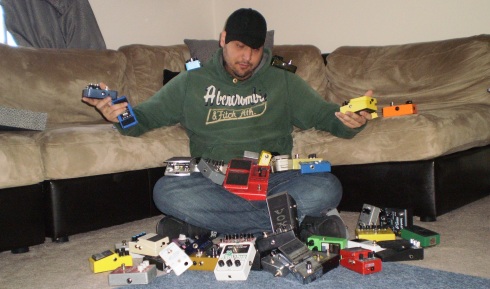So far, these articles have been introductory and have focused on hard fact over interpretation. At the risk of going on a tangent, it seems important to air out some ideas on the tone junkie world. Guitar effects and guitar tone manipulation have been tools that either good guitarists use to innovate, or bad guitarists use in place of practice and developing a skill. For good or evil, for growth or stunting, effects will be used. Our goal at TPL is to explore how they can be used. We are curious.
Effects stompboxes brought effects to the average guitarist’s practice space with increasing popularity through the the 70s and 80s. The 70s saw early development from Electro Harmonix, Boss, MXR, and others, with an interest in fuzz and drive. By the 80s, digital stomp boxes were a staple in any music shop. There was a burst of modulating effects and processors. This meant that effects found a place in almost every guitarist’s rig—hobbyist or pro. Before stomp boxes, you needed larger processors or rack mount effects to experiment. At the time, the only widely available pedals were from what are now mass-market brands, which meant that all tone junkies had the same sounds to work with. We were little, engaged tone junkies with a budding interest. Still, the early stompboxes were a huge leap. Beyond the accessibility factor, these mass-market effects pedals were innovative in sound. The wave of digital effects recreated analog sounds and also brought new sounds to the guitar world.
Then came boutique pedals, which took the stompbox a step further. The small scale is how most pedal companies started, but the rush of boutique pedal makers boomed with ecommerce. A boutique manufacturer has a small team that repairs and modifies existing pedals, as well as developing their own. Usually, boutique pedals and modifications are done by hand. Buying from them can mean a long wait, but it’s a more personal experience, which drives our interest. They gain popularity by offering clones of discontinued pedals, upgrading components, and utilizing true bypass switches. This is the “indie” alternative for tone junkies. We grew up a little, expanded our horizons, dug deeper. Some examples of boutique companies are Foxrox, Skreddy, Analogman, Dr. Scientist, and Paul Trombetta.
Alongside (and in some cases, predating) the boutique companies came a second wave of manufacturers. Second wave companies like TC Electronic, Zvex, Modtone, Way Huge, and others have built a boutique style reputation with large distribution and production elements behind them. They focus on high quality effects, usually have a transparent feel, and often put out some pedals that are unique (Zvex’s Fuzz Facotry, TC Electronic’s PolyTune). These pedals cost more than mass-market stompboxes, but can deliver a better tone if used well. Second wave manufacturers caught the attention of many tone junkies. Some of us swear by them. For the first time, component quality was not inversely related to production quantity. There is a long list of these companies now available at your local guitar shop, right alongside the mass-market brands.
 So what do you do with all these options? We’re pumping money into a market, and that market has grown. We’re all over the skill level chart, and have all bought at least one pedal without “needing” it. Most of us do this regularly. We want to toy with what pedals can do to our tone. I believe the goal is to experiment, grow, and sometimes to build a community around our shared interest. I see many tone junkies go crazy over boutique pedals, act suspicious of second wave pedals, and bash on mass-market pedals. This seems against experimentation. Elements like true bypass are great, but it’s smart to have a mix of buffered and true bypass pedals in your board. Beyond that, there are pedals from mass-market brands that can be the best path to a certain sound. The best reason for this negative attitude that I can think of would be to support smaller companies, but I don’t see many discussions focus on that. Our obsession shouldn’t be divisive.
So what do you do with all these options? We’re pumping money into a market, and that market has grown. We’re all over the skill level chart, and have all bought at least one pedal without “needing” it. Most of us do this regularly. We want to toy with what pedals can do to our tone. I believe the goal is to experiment, grow, and sometimes to build a community around our shared interest. I see many tone junkies go crazy over boutique pedals, act suspicious of second wave pedals, and bash on mass-market pedals. This seems against experimentation. Elements like true bypass are great, but it’s smart to have a mix of buffered and true bypass pedals in your board. Beyond that, there are pedals from mass-market brands that can be the best path to a certain sound. The best reason for this negative attitude that I can think of would be to support smaller companies, but I don’t see many discussions focus on that. Our obsession shouldn’t be divisive.
At TPL, we’re interested in a focused look at what you can do with pedals. That’s what we’re after with Tone Lab and the other sections we’re coming out with–to do more than youtube videos and forums have. Our goal is to open a discussion about how we can utilize pedals, not get snobby. And as more pedal technologies are developed, we’re going to figure out what you can get from them. We want to figure out how pedals shape each other, what pedals you need for certain tones, how to utilize the tools we have access to, and sometimes suggest our favorite pedal investments. We’re also interested in the community. We want the feedback we’re getting. We will continue to be a center for your tone junkie fix.





 Mike explains, Trey adds in the
Mike explains, Trey adds in the 